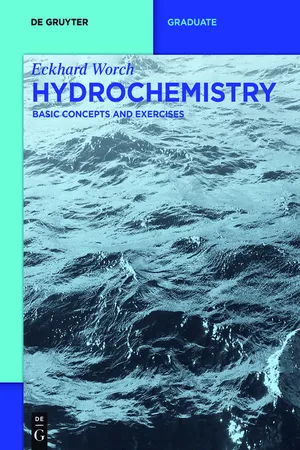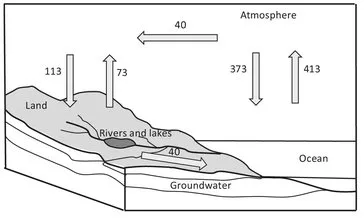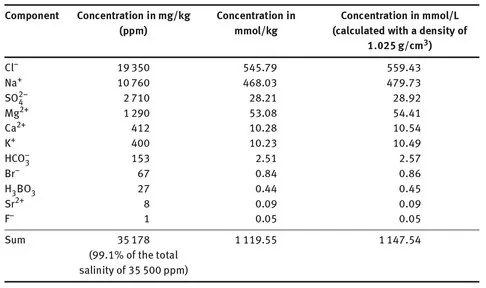![]()
1 Introduction
Water is the basis of all life. For humans, water is essential for survival and therefore irreplaceable. Water is also habitat for aquatic organisms. Furthermore, industry and agriculture are unthinkable without water. Accordingly, the preservation of aquatic ecosystems and the protection of water resources belong to the most important goals of sustainable development.
The quality of water is determined by its constituents, which is the totality of the substances dissolved or suspended in water. A substantiated assessment of water quality therefore requires in-depth knowledge about the occurrence and behavior of these constituents. That explains the importance of hydrochemistry (also referred to as water chemistry or aquatic chemistry) as a scientific discipline that deals with the water constituents and their reactions within the natural water cycle and within the cycle of water use.
Although water, with a total mass of about 1.38 x 1018 t, is the most common molecular substance on earth, its distribution between individual reservoirs is strongly unbalanced (Table 1.1). Approximately 97% of the total water is salt water of the oceans that cannot be consumed by humans directly and is also not suitable for many other purposes due to its relatively high salt content. Although the production of drinking and service water from ocean water is, in principle, possible (e.g. by reverse osmosis), it is unfavorable due to the high energy demand for the treatment processes. Therefore, for drinking and service water production, freshwater is typically used as raw water resource. The most important freshwater resources are the polar ice caps and glaciers as well as groundwater and surface water. From these reservoirs, only parts of surface water and groundwater can be utilized with acceptable technical effort for drinking water or service water purposes. It is estimated that less than 1% of the huge water resource is actually available for human use.
However, the usable freshwater inventories are constantly renewed by the hydrological cycle. Figure 1.1 shows the global water cycle in a very simplified form. Approximately 413 000 km3 of water is transferred by evaporation into the atmosphere each year and the same volume is returned by precipitation to the mainland and to the oceans. The cycle thus resembles a distillation plant whose energy demand, covered by the sun, can be calculated from the enthalpy of vaporization of water (Chapter 2, Section 2.2.3) to be about 1021 kJ/a. For the renewal of freshwater resources the proportion of evaporated water from the oceans that is transported through the atmosphere to the land is of particular importance. This proportion is approximately 40 000 km3 /a.
Table 1.1. Global water resources. Data from Trenberth et al. (2007).
| Water resource | Volume (103 km3) | Portion (%) |
| Oceans | 1 335 040 | 96.95 |
| Polar ice caps and glaciers | 26 350 | 1.91 |
| Groundwater | 15 300 | 1.11 |
| Lakes and rivers | 178 | 0.013 |
| Soil moisture | 122 | 0.009 |
| Permafrost | 22 | 0.0016 |
| Atmosphere | 12.7 | 0.0009 |
| Total | 1 377 024.7 | 100.0 |
Fig. 1.1. The hydrological cycle (volumetric flow rates in 103 km3/a). Data from Trenberth et al. (2007).
A part of the rainwater attains directly the surface water bodies (streams, rivers, lakes, reservoirs) or flows on the land surface into the surface water. Another part of the precipitate, the seepage water, infiltrates into the soil. There it is absorbed by plants or further transported into the ground where it finally reaches the groundwater level. Surface water can also infiltrate into the subsurface where it becomes groundwater. After more or less long residence times and flow paths, groundwater returns to the surface in the form of springs or directly by exfiltration into surface water. The hydrological cycle is completed by evaporation processes and the water runoff to the sea. The evaporation can take place both from the ground and from the water surfaces as well as from the plants. The runoff to the sea occurs via creeks, rivers, and streams.
The different concentration levels of water constituents that we can find in different water bodies can be explained by considering the water cycle as a distillation process as mentioned previously. During evaporation, mainly pure water is transferred to the atmosphere, whereas the solutes (except the very volatile substances) remain in the aqueous phase. Therefore, we can find relatively high concentrations in the oceans (the residue of the distillation). However, the water that is evaporated does not remain pure water over longer times. Already during the transport through the atmosphere, substances (gases, vapors, aerosols) are dissolved. The main input of solutes, however, occurs after the precipitation to the mainland. Dissolution of solids from soils, sediments, aquifers as well as wastewater effluents lead to an increase in the concentrations of inorganic and organic water constituents. Nevertheless the concentrations, in particular of inorganic solutes, in freshwater are typically much lower than in ocean water. The highest ion concentrations in freshwater are in the mg/L range, whereas the highest ion concentrations in seawater are in the g/L range.
Table 1.2. Composition of seawater: Major components with concentrations > 1 ppm.
It follows from the previous discussion that naturally occurring liquid water is never pure H2O, but contains dissolved, colloidally dispersed and coarsely dispersed constituents. Water bodies differ strongly regarding the nature and especially the concentrations of the various constituents. The oceans, which cover about 70% of the Earth’s surface, contain an average of about 3.5% (35 000 ppm) dissolved salts. In ocean water, we can find all the naturally occurring elements, but most of them only in low concentrations. Only a few ions contribute to the high salt content. These are primarily sodium and chloride ions; their total concentration alone amounts to approximately 30 g/kg (3%). The 11 major constituents of seawater that make up about 99% of the total salinity are listed in Table 1.2. The composition of seawater is relatively constant with only very small differences between and within the big oceans. In contrast, marginal seas often show stronger deviations from the total salinity and composition of the big oceans (e.g. Baltic Sea 0.3–1.9% salinity, Mediterranean Sea 3.6–3.9% salinity).
The inorganic composition of freshwaters is characterized by smaller and...


